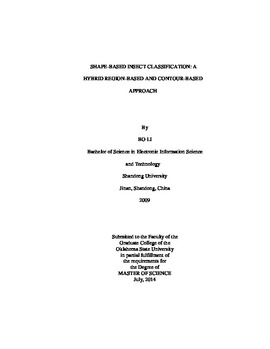| dc.contributor.advisor | Fan, Guoliang | |
| dc.contributor.author | Li, Bo | |
| dc.date.accessioned | 2015-06-17T20:06:44Z | |
| dc.date.available | 2015-06-17T20:06:44Z | |
| dc.date.issued | 2014-07-01 | |
| dc.identifier.uri | https://hdl.handle.net/11244/14965 | |
| dc.description.abstract | The American Burying Beetle (ABB) (Nicrophorus americanus) is a critically endangered insect whose distribution is limited to several states at the periphery of its historical range in the eastern and central United States. The objective of this study is to develop a digital image classification algorithm that will be used in an autonomous monitoring system to be attached to existing ABB traps that will detect, image, classify and report insects to species as they enter the trap. A training set of 92 individual specimens representing 11 insect species with shape similarity from the Oklahoma State University Entomology Museum was used in this study. Starting with a color digital image, an unsupervised preprocessing algorithm extracts each insect shape, converts it to a binary image, and then aligns it for classification using pattern recognition techniques. For region-based and contour-based shape representation methods, an area component and a Fourier descriptor methods are implemented for shape representation and classification. Analysis of initial classification results revealed that the pose variability of insect legs and antennae introduced excessive uncertainty in the feature space. To address this, a novel shape decomposition algorithm based on curvature theory is proposed to remove legs and antennae from the insect shape automatically prior to classification. This shape decomposition approach increased overall classification accuracy from 64% to 76% and 57% to 67% for area component and Fourier descriptor methods respectively. To further improve classification accuracy, a hybrid approach using a decision fusion technique has also been implemented after initial classification by each method. This resulted in 100% classification accuracy for ABB and 90% overall classification accuracy for the 11 species (total 92 images) investigated. | |
| dc.format | application/pdf | |
| dc.language | en_US | |
| dc.publisher | Oklahoma State University | |
| dc.rights | Copyright is held by the author who has granted the Oklahoma State University Library the non-exclusive right to share this material in its institutional repository. Contact Digital Library Services at lib-dls@okstate.edu or 405-744-9161 for the permission policy on the use, reproduction or distribution of this material. | |
| dc.title | Shape-based Insect Classification: a Hybrid Region-based and Contour-based Approach | |
| dc.type | text | |
| dc.contributor.committeeMember | Hardin, James | |
| dc.contributor.committeeMember | Chandler, Damon M. | |
| osu.filename | Li_okstate_0664M_13535.pdf | |
| osu.accesstype | Open Access | |
| dc.description.department | Electrical Engineering | |
| dc.type.genre | Thesis | |
| dc.subject.keywords | computer vision | |
| dc.subject.keywords | insect classification | |
| dc.subject.keywords | pattern recognition | |
| dc.subject.keywords | shape decomposition | |
